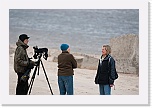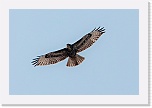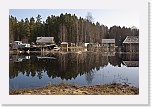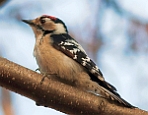<<- Main site
 Liivin lahti ja Kolkan niemi 21. - 25.4. 2011
Liivin lahti ja Kolkan niemi 21. - 25.4. 2011
Latvian puolella jatkoimme Via Balticaa. Heti Ainain kaupungissa on hyvä turisti-info, sieltä keräsimme mukaan nipun esitteitä Latvian luontopaikoista. Latviassa on esitteisiin ja turistien neuvontaan selvästi panostettu.
Turistien kanssa tekemisiin joutuvat puhuvat auttavasti saksaa tai englantia mutta tavallisen kansan kanssa keskustelu sujuu parhaiten venäjäksi. Nella osaa sitä hyvin kuten lähes kaikki kohtaamme latvialaisetkin. Näin olleen meillä ei ollut mitään kommunikointiongelmia, sillä kielen puolesta matkustimme kuin kotimaassa.
Hintataso on Latviassa oikein miellyttävä. Kaksi henkilöä ruokailee 10-12 eurolla mukavasti ja ruokakaupasta saa kahdella kymmenellä eurolla paljon evästä.
Ajoimme suoraan Riian läpi Liivin lahtea myötäilevälle rantatielle. Läpiajo on hyvin opastettu mutta Riga on suuri kaupunki ja läpiajo vei aikaa. Iltapäivä olikin jo pitkällä, kun ehdimme Jurmalaan. Se ei meitä suuremmin kiehtonut ja löysimme yöpaikaksi Villa Anna-nimisen kylpylähotellin Apuciemes-nimisestä pikkukylästä. Se on uusi ja aika kliinisen tuntuinen paikka Liivin lahden rannalla. Yöpymisen hintakin ihan suomalaista tasoa. Tässä kohtaa ranta oli sula, mutta jäätä näkyi kauempana lahdella. Lintuja ei tässä rannassa ollut lainkaan.
Seuraavana aamuna retkeilimme Engures- järven rannoilla. Siellä on paljon alkuperäistä luontoa ja vanhoja puoleksi romahtaneita taloja. Kumisaappaat ovat tähän aikaan vuodesta välttämättömät. Pohjoisen rannan lintutorni oli huonokuntoisuuden takia suljettu. Järvellä näkyi joutsenia, hanhia ja suohaukkoja.
Majoituksen olimme varanneet neljäksi yöksi Kolkan niemeltä Kosragsin kylästä, Pitagi-nimisestä lomakylästä.( email: signe.dislere@gmail.com ) Omistajapariskunta on rakentanut erikokoisia mökkejä, joissa tarjoaa majoitusta ja ruokapalvelua. Tätä paikkaa voi suositella täydellä sydämellä. Erityisesti Signe-rouvan ruuat ovat maittavia ja annokset hirmuisen runsaita. Hän varoittikin ensimmäisenä iltana, että Latviassa syödään paljon. Todella runsaan alku-, pää- ja jälkiruuan jälkeen väsynyt matkailija voi vain ähkiä tyytyväisenä ja selata päivän kuvasaalista. Täälläkin ruokajuomana tarjottiin koko ajan koivun mahlaa.
Kosragista on lyhyt matka Kolkan niemen kärkeen. Siinä itämeri muuttuu Liivin lahdeksi. Paikan nimi tulee liivin kielestä, joka on suomen ja viron sukulaiskieli (tai valitettavasti oli sitä). Sananmukaisesti nimi tarkoittaa vihoviimeistä kolkkaa. Tästä on Saarenmaalle lyhyt matka. Säären majakka näkyikin sieltä kaukoputkella hyvin.
Niemen pituussuunnassa kulkeva tie on aivan uusi ja osin vielä rakenteilla. Ehdottomasti paras tien pätkä Latviassa, jossa soratiet ja paikatut kestopäällysteet ovat muuten arkipäivää. Kolkan niemellä oli aamuisin ajoittain runsasta pikkulintujen muuttoa. Pääosin ne olivat peippoja, rastaita ja kyyhkysiä, yksi harjalintukin osui kuvaan. Vesilintuja matkasi kauempana selällä pienissä parvissa. Rannan tuntumassa vaani joukko varpushaukkoja muuttavia pikkulintuja.
Ajelimme myös sisämaassa pikkukylissä. Niissä on sellainen viipyilevä 50-luvun tunnelma. Kattohaikaroita ja haukkoja näkyi paljon. Menomatkalla risteilimme etelämpänä Jelgavan kaupungin pohjoispollella, jossa on Lielupe ja Svete-jokien välissä hienot kosteikot. Niillä lepäili paljon hanhia. Oppaana käytimme Gerard Gormanin kirjaa "Birding in Eastern Europe".
 Valokuvia
Valokuvia




 Livonian Bay and cape of Kolka 21. - 25. April 2011
Livonian Bay and cape of Kolka 21. - 25. April 2011
On Latvia's side we continued the road Via Baltica. Immediately in the town Ainazi there is a good tourist information office. We collected there a bunch of brochures from Latvia's nature places from there along. In Latvia it has been invested in the brochures and the tourists' advice distinctly.
Tourists office people speak German or English helpingly but the discussion with the ordinary Latvians goes best in Russian. Nella knows it well, nearly all the Latvians, we meet did so also. Thus we had no communication problems. For language we travelled like in the home country. The price level is quite pleasing in Latvia. Two persons eat comfortably on 10-12 euros and from the grocer's shop you get on twenty Euros a lot to eat.
We drove directly through Riga as an objective to the shore road which follows the Livonian Bay. The route is well guided but Riga is a big town and it takes time. Afternoon indeed was already far when we were in Jurmala. It did not fascinate us more greatly and we found a spa hotel called Villa Anna in the village called Apuciemes as a night place. It is new place on the shore of the bay. Price of the staying overnight was also quite on Finnish level. There is a shore here, it was unfrozen but ice was seen more far on the bay. There were no birds in this shore at all.
During the following morning we hiked on the shores of the lake Engures. There is much original nature and old ones houses which have half collapsed. The rubber boots will be necessary since the year this time. The bird tower of the northern shore had been closed because of the unsoundness. At the lake were seen swans, geese and swamp hawks.
We had reserved the accommodation for four nights from the village Kosrags from the cape of Kolka. The name of the place is Pitagi (email: signe.dislere@gmail.com ). The owner couple has built cottages of different sizes and offer the accommodation and food service. This place can be recommended on a full heart. Especially the house lady Signes foods are tasty and the portions of awfully abundant ones. She indeed warned on the first evening that in Latvia it is eaten a lot. After a really abundant appetizer, main course and dessert the tired tourist can only groan satisfied and browse the picture catch of the day. Also here the sap of the birch was offered all the time as a food drink.
From Kosrags it is a short trip to the point of the cape of Kolka. It is Livonian and mens literally the very last corner. The Livonian language is the relative language of Finnish and Estonian (or unfortunately it was, because Latvians speak nowadays other language). There is a short trip from there to Saaremaa Estonia. The lighthouse of the Sääre indeed was well seen from there on the telescope.
The road which goes in the longitudinal direction of the cape is quite new and still partly on the structures. It was the absolutely best short piece of the road in Latvia where the gravel roads and patched coatings are part of everyday life otherwise. On the cape of the corner there was the small birds' abundant migration in the mornings. Mainly they were chaffinches, thrushes and doves. One hoopoe also hit a picture. The water birds travelled more far in the small swarms on the back. Near a shore a group of sparrow hawks lurked for the changing small birds.
We also were driving in the small villages nearby. In them there was the atmosphere of the 50's. White storks and a lot of hawks were seen. On the going way to the south we cruised more between rivers Lielupe and Svete at the north of the town Jelgava. There were fine wetlands. With them lounged many geese. As a guide we used Gerard Gormans book, "Birding in Eastern Europe".
 Pictures
Pictures
 Liivin lahti ja Kolkan niemi 21. - 25.4. 2011
Liivin lahti ja Kolkan niemi 21. - 25.4. 2011
 Valokuvia
Valokuvia



 Livonian Bay and cape of Kolka 21. - 25. April 2011
Livonian Bay and cape of Kolka 21. - 25. April 2011